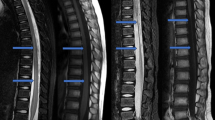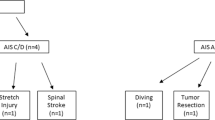Abstract
Study design:
Systematic review.
Objectives:
The objective of this study is to systematically review the literature for pediatric cases of spinal cord injuries without radiologic abnormality (SCIWORA) to investigate any possible relationship between initial neurologic impairment and eventual neurologic status.
Setting:
A university department of orthopedics.
Methods:
Following the preferred reporting items for systemic reviews and meta-analysis (PRISMA) guidelines for systematic review, the databases of PubMed and OvidSP were electronically searched for articles that use individuals under 18 years old, have trauma resulting in spinal cord injury and have no fractures or dislocations on radiographs. When available, the patients’ age, sex, mechanism of injury and spinal cord level were recorded. Individuals with cervical injury, who had specific information on cervical level and mechanism of injury, were recorded as well. Patients who reported specific magnetic resonance imaging findings and the time from the injury were also reported. When possible, the American Spinal Injury Association Impairment Scale (AIS) was determined initially after the injury and then at last follow-up.
Results:
A total of 433 pediatric patients were identified with SCIWORA. The most prevalent mechanism of injury was sports-related injury cases (39.83%) followed by fall (24.18%) and motor vehicle-related (23.18%) injuries. The mean improvement recorded for all patients was 0.89 AIS grades.
Conclusion:
The most common mechanism of injury was sports-related and cervical injury, which occurred more frequently than other levels. Initial AIS grade A showed poorer outcomes in the pediatric population compared with the adult population. Initial presentation of D showed the highest likelihood of no permanent neurologic impairment (AIS of E).
Similar content being viewed by others
Log in or create a free account to read this content
Gain free access to this article, as well as selected content from this journal and more on nature.com
or
References
Pang D, Wilberger JE Jr . Spinal cord injury without radiographic abnormalities in children. J Neurosurg 1982; 57: 114–129.
Pang D . Spinal cord injury without radiographic abnormality in children, 2 decades later. Neurosurgery 2004; 55: 1325–1342 discussion 42-3.
Matsumura A, Meguro K, Tsurushima H, Kikuchi Y, Wada M, Nakata Y . Magnetic resonance imaging of spinal cord injury without radiologic abnormality. Surg Neurol 1990; 33: 281–283.
Launay F, Leet AI, Sponseller PD . Pediatric spinal cord injury without radiographic abnormality: a meta-analysis. Clin Orthop Relat Res 2005, 166–170.
Baker C, Kadish H, Schunk JE . Evaluation of pediatric cervical spine injuries. Am J Emerg Med 1999; 17: 230–234.
Bondurant CP, Oro JJ . Spinal cord injury without radiographic abnormality and Chiari malformation. J Neurosurg 1993; 79: 833–838.
Bosch PP, Vogt MT, Ward WT . Pediatric spinal cord injury without radiographic abnormality (SCIWORA): the absence of occult instability and lack of indication for bracing. Spine 2002; 27: 2788–2800.
Brown RL, Brunn MA, Garcia VF . Cervical spine injuries in children: a review of 103 patients treated consecutively at a level 1 pediatric trauma center. J Pediatr Surg 2001; 36: 1107–1114.
Buldini B, Amigoni A, Faggin R, Laverda AM . Spinal cord injury without radiographic abnormalities. Eur J Pediatr 2006; 165: 108–111.
Carreon LY, Glassman SD, Campbell MJ . Pediatric spine fractures: a review of 137 hospital admissions. J Spinal Disord Tech 2004; 17: 477–482.
Corduk N, Koltuksuz U, Karabul M, Savran B, Bagci S, Sarioglu-Buke A . A rare presentation of crush injury: transanal small bowel evisceration. Case report and review of the literature. Pediatr Surg Int 2011; 27: 1021–1024.
Dickman CA, Zabramski JM, Hadley MN, Rekate HL, Sonntag VK . Pediatric spinal cord injury without radiographic abnormalities: report of 26 cases and review of the literature. J Spinal Disord 1991; 4: 296–305.
Duprez T, De Merlier Y, Clapuyt P, Clement de Clety S, Cosnard G, Gadisseux JF . Early cord degeneration in bifocal SCIWORA: a case report. spinal cord injury without radiographic abnormalities. Pediatr Radiol 1998; 28: 186–188.
Ergun A, Oder W . Pediatric care report of spinal cord injury without radiographic abnormality (SCIWORA): case report and literature review. Spinal Cord 2003; 41: 249–253.
Feldman KW, Avellino AM, Sugar NF, Ellenbogen RG . Cervical spinal cord injury in abused children. Pediatr Emerg Care 2008; 24: 222–227.
Florensa Vila J, Lopez-Dolado E, Arzoz Lezaun T, Gomez-Arguelles JM, Sebastian de la Cruz F, Oliviero A . A severe case of high cervical spinal cord injury without radiographic abnormality. Eur Neurol 2010; 63: 188.
Grubenhoff JA, Brent A . Case report: Brown-Sequard syndrome resulting from a ski injury in a 7-year-old male. Curr Opin Pediatr 2008; 20: 341–344.
Hamilton MG, Myles ST . Pediatric spinal injury: review of 174 hospital admissions. J Neurosurg 1992; 77: 700–704.
Izma MK, Zulkharnain I, Ramli B, Muhamad AR, Harwant S . Spinal cord injury without radiological abnormality (SCIWORA). Med J Malaysia 2003; 58: 105–110.
Kim SH, Yoon SH, Cho KH, Kim SH . Spinal cord injury without radiological abnormality in an infant with delayed presentation of symptoms after a minor injury. Spine 2008; 33: E792–E794.
Lee CC, Lee SH, Yo CH, Lee WT, Chen SC . Complete recovery of spinal cord injury without radiographic abnormality and traumatic brachial plexopathy in a young infant falling from a 30-feet-high window. Pediatr Neurosurg 2006; 42: 113–115.
Liao CC, Lui TN, Chen LR, Chuang CC, Huang YC . Spinal cord injury without radiological abnormality in preschool-aged children: correlation of magnetic resonance imaging findings with neurological outcomes. J Neurosurg 2005; 103 (1 Suppl): 17–23.
Mahajan P, Jaffe DM, Olsen CS, Leonard JR, Nigrovic LE, Rogers AJ et al. Spinal cord injury without radiologic abnormality in children imaged with magnetic resonance imaging. J Trauma Acute Care Surg 2013; 75: 843–847.
Mann DC, Dodds JA . Spinal injuries in 57 patients 17 years or younger. Orthopedics 1993; 16: 159–164.
Mortazavi MM, Mariwalla NR, Horn EM, Tubbs RS, Theodore N . Absence of MRI soft tissue abnormalities in severe spinal cord injury in children: case-based update. Childs Nerv Syst 2011; 27: 1369–1373.
Pollina J, Li V . Tandem spinal cord injuries without radiographic abnormalities in a young child. Pediatr Neurosurg 1999; 30: 263–266.
Robles LA . Traumatic spinal cord infarction in a child: case report and review of literature. Surg Neurol 2007; 67: 529–534.
Sanchez B, Waxman K, Jones T, Conner S, Chung R, Becerra S . Cervical spine clearance in blunt trauma: evaluation of a computed tomography-based protocol. J Trauma 2005; 59: 179–183.
Shen H, Tang Y, Huang L, Yang R, Wu Y, Wang P et al. Applications of diffusion-weighted MRI in thoracic spinal cord injury without radiographic abnormality. Int Orthop 2007; 31: 375–383.
Trigylidas T, Yuh SJ, Vassilyadi M, Matzinger MA, Mikrogianakis A . Spinal cord injuries without radiographic abnormality at two pediatric trauma centers in Ontario. Pediatr Neurosurg 2010; 46: 283–289.
Trumble J, Myslinski J . Lower thoracic SCIWORA in a 3-year-old child: case report. Pediatr Emerg Care 2000; 16: 91–93.
Wang MY, Hoh DJ, Leary SP, Griffith P, McComb JG . High rates of neurological improvement following severe traumatic pediatric spinal cord injury. Spine 2004; 29: 1493–1497 discussion E266.
Yamaguchi S, Hida K, Akino M, Yano S, Saito H, Iwasaki Y . A case of pediatric thoracic SCIWORA following minor trauma. Childs Nerv Syst 2002; 18: 241–243.
Platzer P, Jaindl M, Thalhammer G, Dittrich S, Kutscha-Lissberg F, Vecsei V et al. Cervical spine injuries in pediatric patients. J Trauma 2007; 62: 389–396 discussion 94-6.
Ouyang J, Zhu Q, Zhao W, Xu Y, Chen W, Zhong S . Biomechanical assessment of the pediatric cervical spine under bending and tensile loading. Spine 2005; 30: E716–E723.
Bou-Haidar P, Peduto AJ, Karunaratne N . Differential diagnosis of T2 hyperintense spinal cord lesions: part B. J Med Imaging Radiat Oncol 2009; 53: 152–159.
Boese CK, Lechler P . Spinal cord injury without radiologic abnormalities in adults: a systematic review. J Trauma Acute Care Surg 2013; 75: 320–330.
Author information
Authors and Affiliations
Corresponding author
Ethics declarations
Competing interests
The authors declare no conflict of interest.
Rights and permissions
About this article
Cite this article
Carroll, T., Smith, C., Liu, X. et al. Spinal cord injuries without radiologic abnormality in children: a systematic review. Spinal Cord 53, 842–848 (2015). https://doi.org/10.1038/sc.2015.110
Received:
Revised:
Accepted:
Published:
Issue date:
DOI: https://doi.org/10.1038/sc.2015.110
This article is cited by
-
Clinical characteristics analysis of pediatric spinal cord injury without radiological abnormality in China: a retrospective study
BMC Pediatrics (2024)
-
Spinal cord injury without radiologic abnormality: an updated systematic review and investigation of concurrent concussion
Bulletin of the National Research Centre (2023)
-
Real spinal cord injury without radiologic abnormality in pediatric patient with tight filum terminale following minor trauma: a case report
BMC Pediatrics (2019)
-
Management of cervical spine trauma in children
European Journal of Trauma and Emergency Surgery (2019)
-
Spondylotic traumatic central cord syndrome: a hidden discoligamentous injury?
European Spine Journal (2019)



